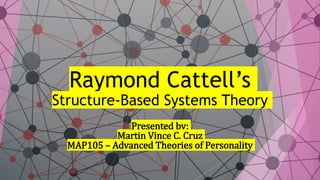
Raymond cattell
- 1. Raymond Cattell’s Structure-Based Systems Theory Presented by: Martin Vince C. Cruz MAP105 – Advanced Theories of Personality
- 2. Biographical Sketch (1905-1998) Born: 1905 in Staffordshire, England 1914 – World War I. The war had an impact on him Bachelor’s – University of London (1924) – Chemistry & Physics Ph.D – University of London (1929) – Psychology Studied under Charles Spearman 1937 – Honorary Doctorate of Science and an associate to Thorndike Psychology could be studied objectively and quantitatively Died: February 2, 1998
- 3. What is Personality? Personality is that which permits a prediction of what a person will do in a given situation. 𝑅 = 𝑓 𝑃, 𝑆 Traits assists us in the understanding of structure and function of personality “A response is a function of the person and the stimuli” Predetermined by experimentsLess well-known factor that needs to be further studied
- 4. What are Traits? These are the relatively permanent reaction tendencies that are the basic structural functions of the personality. Common Traits: possessed by everyone to a certain degree Unique Traits: possessed by one or a few Ability Traits: determines how efficiently we will work toward a goal Temperament Traits: general style of responding Dynamic Traits: driving forces of our behavior Ergs: basic units of motivations Sentiments: environmental-mold source traits motivating behavior Attitudes: specific tendencies and actions Dynamic Lattice: the complex organization of dynamic traits Subsidiation: the process where certain dynamic traits are dependent on other traits
- 6. What are Traits? Surface Traits: correlate with one another but do not constitute a factor Source Traits: unitary, stable, permanent Constitutional Traits: has biological origins, but not necessarily innate Environmental-mold Traits: obtained from the influences of social and physical environments
- 7. Factor Analysis Step 1: Specific observations and quantification Step 2: Determination of correlation coefficients and intercorrelations Step 3: Derivation of factors into small amounts Factor Loading – correlation of scores with the factors 2 Factor Analytic Techniques R-technique – testing large group of participants a variety of personality tests and intercorrelate their scores P-technique – discover the unique trait structure of a single individual
- 8. Factor Rotations ORTHOGONAL (VARIMAX) Used by the proponents of the Five-Factor Theory As the scores on the x-variable increases, the y-value may have any value Minimal covariation OBLIQUE (OBLIMIN) Used by Cattell Allows covariation and correlation between factors
- 9. Example of a Factor Analytic Study Output
- 10. Results of Cattell’s Factor Analytic Study: The Sixteen Source Traits: Factor Low-Scores High-Scorers A (Warmth) Reserved Outgoing B(Intelligence) Less Intelligent More Intelligent C(Emotional Stability) Low Ego Strength High Ego Strength E(Dominance) Humble Assertive F(Liveliness) Sober Happy-go-lucky G(Rule Consciousness) Lack of internal standard Strong conscience H (Social Boldness) Shy Adventuresome I (Sensitivity) Tender-minded Tough-minded Factor Low-Scorers High Scorers L (Vigilance) Suspicious Trustiing M (Abstractedness) Practical Imaginative N (Privateness) Forthright Shrewd O (Apprehension) Self-assured Apprehensive Q1 (Openness to Change) Conservative Experimental Q2 (Self-Reliance) Self- sufficient Group- dependent Q3 (Perfectionism) Controlled Casual Q4 (Tension) Tense Relaxed
- 11. 16 Source Traits and the Second-Order Factors FACTORS SOURCE TRAITS I – Extraversion (x Introversion) A+ F+ H+ N- Q2- Introvert Socially Inhibited Extrovert Socially Bold II – Anxiety (x Stability) C- L+ O+ Q4+ Low Anxiety Emotionally stable High Anxiety Emotionally reactive III – Though Mindedness (x Openness) A- I- M- Q1- Receptive Open Minded Intuitive Inflexible Firm Low Empathy IV – Independence (x Accommodation) E+ H+ L+ Q1+ Accommodated Submissive Self-sacrificing Independent Persuasive Focused on the future V – Self-control (x Lack of inhibition) F- G+ M- Q3+ Vigilant Impulsive Controlled Inhibited
- 12. Econetic Model Human behavior is a result of complex and subtle interplay between traits and situations. Cattell constructed a taxonomy of situations or environments.
- 13. Dynamic Calculus 𝑅 = (𝑏1 𝐴1+ 𝑏2 𝐴2… + 𝑏 𝑛 𝐴 𝑛) + (𝑏1 𝐵1+ 𝑏2 𝐵2… + 𝑏 𝑛 𝐵𝑛) + (𝑏1 𝐶1+ 𝑏2 𝐶2… + 𝑏 𝑛 𝐶 𝑛) + (𝑏1 𝐾1+ 𝑏2 𝐾2… + 𝑏 𝑛 𝐾 𝑛) where: R = response of the individual in a given situation A = source traits B = states and moods C = social and cultural meanings K = unspecified factors b = weights
- 14. Heredity and Environmental Influences Conducted among twin pairs or siblings Intelligence is inherited Emotional responses are learned Parents have a significant influence Supported Adler’s theory on birth order, especially of the oldest (high in ego strength & dominance)
- 15. Stages of Development Stage Age Characteristic Infancy Birth – 6yrs of age Highly influenced by parents and siblings; development of social attitudes Childhood 6 yrs – 14 yrs Move toward independence & identification with peers Adolescence 14 yrs – 23 yrs Troublesome and stressful Maturity 23 yrs – 50 yrs Productivity; less flexibility; changes in interests and attitudes Late Maturity 50 yrs – 65 yrs Development in response to the changes Old Age 65 onward Adjustments based on the losses
- 16. Abnormal Behavior Neurosis Manifested by clients who come to a clinic due to emotional difficulties May be due to various antecedent factors: familial confilict, inconsistent discipline, insufficient affection, high moral standards, genetically below average emotional stability. Psychosis The lost of contact with reality and the need for hospitalization to protect oneself and others. Lacks ego strength, pessimistic, seclusive, subdued, shy, aloof, introverted and conceited, and motivated by sexual and aggressive urges.
- 17. Assessment in Cattell’s Theory • Life Records • Ratings from observed dataL-Data • Questionnaires • Subjects rate themselvesQ-Data • Personality Tests • “objective” as it is resistant to fakingT-Data
- 18. Rating Cattell’s Theory Generates Research 5 5 3 1 2Falsifiable Organize and Explain Offer practical solutions Internally Consistent Parsimonious 1
- 19. Cattell’s View of Human Nature FREE WILL DETERMINISM CONSCIOUS UNCONSCIOUS OPTIMISM PESSIMISM TELEOLOGY CAUSALITY NATURE NURTURE UNIQUENESS UNIVERSALITY
- 20. “ ” Thank you for listening Keep safe and God Bless
Editor's Notes
- Cattell used two techniques for his factor analytic studies
- Orthogonal Oblique
